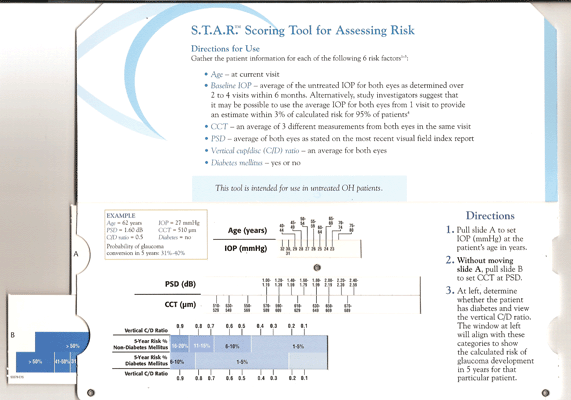 |
A 48-year-old black male presented to the clinic in early 2005 as a new patient. He had a history of being monitored for glaucoma, but he was not taking any ophthalmic medications. Current medications included Actos (pioglitazone, Takeda), Avandia (rosiglitazone, GlaxoSmithKline), metoprolol, Vytorin (ezetimibe/simvastatin, Merck/Schering-Plough) and 81mg aspirin. He had a myocardial infarction four years earlier. During his cardiovascular workup, his doctors detected diabetes and started medications at that time. He was unsure of his HbA1c level.
He reported he was monitored for high pressures in his eyes for about 10 years, and that he had a few visual field tests but none in the past three years. He was now interested in re-establishing care.
Diagnostic Data
Best-corrected acuity at the initial visit was 20/20 O.D. and O.S. through minimal hyperopic astigmatic presbyopic correction. Pupils were equal, round and reactive to light with no afferent pupillary defect. Slit lamp examination of his anterior segments was essentially unremarkable. Pachymetry readings were 572m O.D. and 569m O.S. Applanation tensions were 28mm Hg O.D. and 29mm Hg O.S.
Gonioscopic examination demonstrated grade IV open angles O.U. with a moderate amount of trabecular pigmentation. There were no iris or angle abnormalities, including neovascularization.
 |
|
The STAR calculator predicts glaucoma risk In this case, the exception proved the rule. |
Digital stereo optic nerve images were obtained for future reference.
Threshold visual fields demonstrated no visual field defects associated with glaucomatous optic neuropathy.
Management
I elected to monitor the patient based primarily on the fact that his CCTs were relatively thick, and his optic nerves observed the ISNT rule, which maintains that in normal optic nerve anatomy, the inferior rim is generally the thickest, followed by the superior, nasal and temporal rims respectively. Other reasons that factored into my decision to monitor: He was apparently monitored for 10 years without change, and he was a new patient.
Nine months later, his IOPs were 29mm Hg O.D. and O.S. Threshold visual fields in the left eye demonstrated two areas in the paracentral region close to the blind spot that were flagged as abnormal. Stereoscopic examination of the optic nerve O.D. showed no change from baseline image overlay. Contours of the neuroretinal rim O.S. also showed no change from baseline, but there was a distinct nerve fiber layer hemorrhage on the optic disc at 12 oclock. His retina remained unchanged. His HbA1c level was 7.3%.
Discussion
One of the tools that can help patients understand the change in their situation is a digital image. The obvious presence of the new hemorrhage on the left optic disc was enough to get his attention and facilitate his understanding that indeed things had changed, and therapy was warranted.
Another useful tool that can be used for the same effect is one of the risk calculators available for ocular hypertensive patients, such as the new STAR (Scoring Tool for Assessing Risk) calculator. The STAR risk calculator is based primarily on data culled from the Ocular Hypertension Treatment Study and was developed to give eye-care providers a somewhat systematic approach to evaluating patients five-year risk of progressing from ocular hypertension to glaucoma.
The main risk profiles in the STAR risk calculator include age, IOP, CCT, pattern standard deviation, vertical cup-to-disc ratio, and presence or absence of diabetes. The device is similar to a slide rule.
When I entered this patients data into the calculator, his five-year risk of converting to glaucoma was a low 1% to 5%. Most experts agree that when the five-year risk is less than 5%, the patient should be monitored. When the risk is greater than 15%, you should consider initiating treatment.
Despite the results of the risk calculator, I am starting therapy for this patient, especially in his left eye. Why? The answer lies in both the patient and the calculator itself. There is no question that the risk of progressing to glaucoma and optic nerve rim tissue loss are significantly increased when disc (Drance) hemorrhages develop, which this patient did develop in his left eye. And that fact holds true whether you are dealing with an ocular hypertensive who you are simply monitoring (as in this case) or in an established medicated glaucoma patient who is undergoing therapy.
Secondly, the risk calculator itself is only a guide to evaluating an ocular hypertensives risk of converting to glaucoma. In fact, the developers of the STAR calculator clearly state: This tool is not intended to substitute for your clinical experience and judgment. Appropriate treatment will vary based on individual patient characteristics.
A similar comparison can be made with the ocular hypertensive patient who has thick corneas. According to OHTS, such patients have a low risk of converting to glaucoma. But some patients who have thick corneas do in fact have glaucoma, such as the patient in this case.
Did I show this patient the risk calculator and its prediction of low likelihood of conversion? No, because it would have conflicted with my patient education discussion.
Did I use the calculator to make a therapeutic decision? No. In fact, I disagreed with its recommendations and medicated the patient with Travatan (travoprost, Alcon) 1 drop O.U. h.s.
But if the question is, Would I use it to educate a patient or to determine a patients five-year risk of developing glaucoma? then the answer is a resounding yes, keeping in mind that it serves as a guide, and not a hard-and-fast set of rules.

